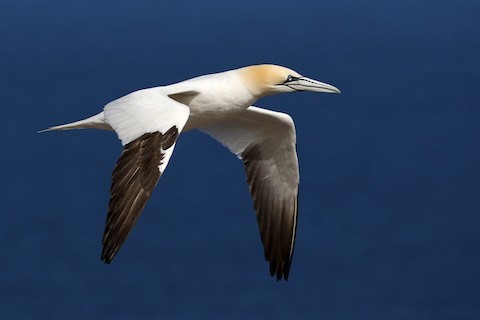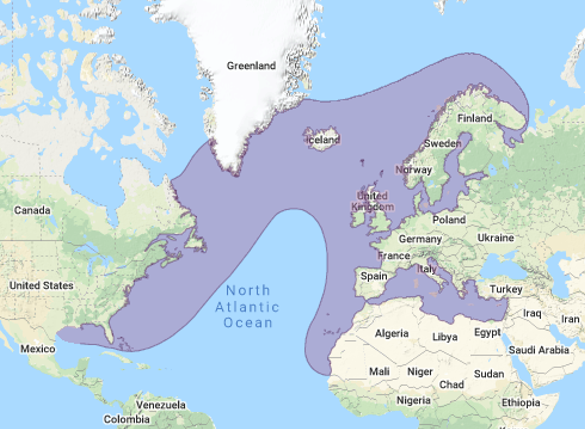Birdfinding.info ⇒ Common along temperate coasts on both sides of the North Atlantic. From October through April, it can be found along most of the Atlantic coast of the U.S. In eastern Canada, from April to September, two breeding colonies are tourist attractions: Bonaventure Island, Quebec, and Cape St. Mary’s, Newfoundland. In the British Isles, there are many accessible colonies, including Bempton Cliffs in North Yorkshire and Tantalon Castle, Scotland.
Northern Gannet
Morus bassanus
North Atlantic Ocean and adjacent seas.
Breeding. Breeds from March to September in large colonies (known as “gannetries”) in eastern Canada, Iceland, and northwestern Europe.
In Europe, there are approximately 35 to 40 established gannetries from Iceland and northern Norway south to French islands in the English Channel. The largest gannetry, with about 50,000 pairs, is at St. Kilda in the Outer Hebrides of Scotland.
New European colonies form from time to time, with a general northward trend. The northernmost outpost is on Bear Island (western Barents Sea, south of Svalbard), first noted in 2011.
The North American population is approximately 50,000 pairs at six gannetries: three in eastern Quebec and three in Newfoundland. About half of the Canadian population nests at Bonaventure Island off the tip of Quebec’s Gaspé Peninsula. The remaining half is about evenly divided among Bird Rock (Magdalen Islands), Cape St. Mary’s, and Funk Island, with two much smaller colonies at Baccalieu Island (eastern Newfoundland) and Falaise aux Goélands (Anticosti Island).
Nonbreeding. Disperses widely across the North Atlantic, mainly in coastal and near-coastal waters from Newfoundland, Iceland, and northern Scandinavia south to the Gulf of Mexico, the Bahamas, Azores, the Mediterranean Sea, and Senegal.
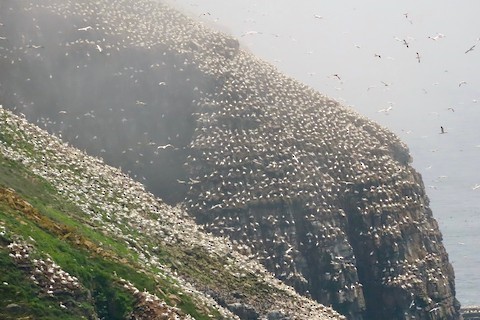
Northern Gannet colony. (Cape St. Mary’s Ecological Reserve, Newfoundland; July 16, 2019.) © Ted Floyd
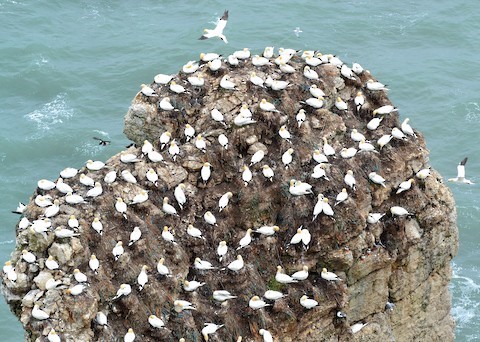
Northern Gannet colony. (Bempton Cliffs RSPB Reserve, Yorkshire, England; June 3, 2016.) © A. Emmerson
Although much more numerous and widespread in winter, some nonbreeders are present year-round nearly throughout its oceanic range.
Occasionally wanders farther afield, with vagrants having reached eastern Mexico, Puerto Rico, the Lesser Antilles (to Grenada), and Sierra Leone.
In fall a few juveniles often wander up the St. Lawrence River to the Great Lakes.
There is a single record from the Pacific Ocean of what seems likely to be a single bird seen over the years in many locations along the central California coast, including San Francisco Bay and the Farallon Islands from at least 2012 to 2020.
Identification
The only gannet in the North Atlantic and often recognizable on that basis, but immature plumages are confusing and resemble various immature boobies.
Adults are distinctive: white overall with a buffy blush on head and nape, blackish facial skin, and ivory bill with blackish seams and edges.
At rest, the only black plumage visible is the tips of the folded wings.
The feet are mostly black with fine greenish-yellow lines on the ridges.
In flight, adult appears predominantly white except for the wings, which are mostly black from the wrist out.

Northern Gannet pair in colony. (Helgoland, Germany; June 15, 2019.) © Thomas Doebel
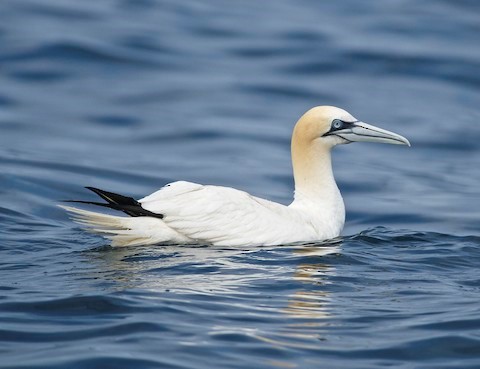
Northern Gannet. (Offshore from Pubnico, Nova Scotia; August 13, 2016.) © Paul Gould
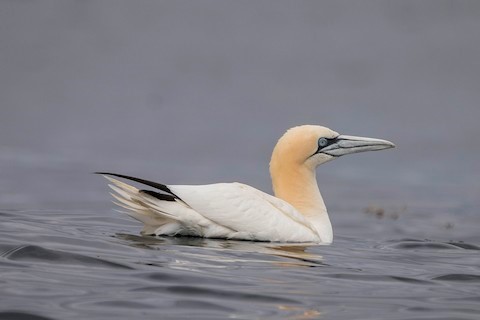
Northern Gannet. (Strait of Belle Isle, Labrador; July 30, 2019.) © Vernon Buckle
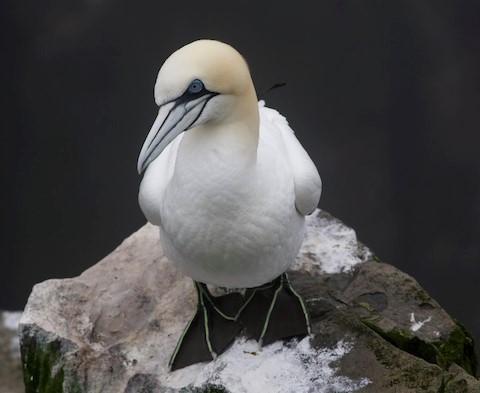
Northern Gannet. (Cape St. Mary’s Ecological Reserve, Newfoundland; July 16, 2019.) © Nick Lund
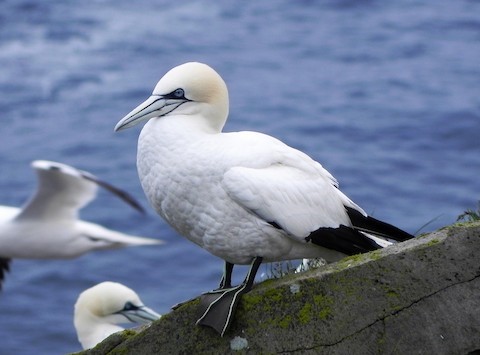
Northern Gannet. (Cape St. Mary’s Ecological Reserve, Newfoundland; June 1, 2009.) © Kirby Adams

Northern Gannet. (Machias Seal Island, Maine; May 23, 2019.) © Kyle Lima
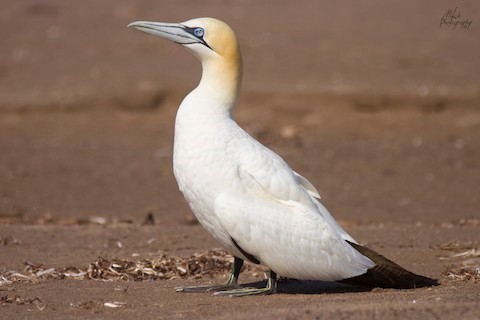
Northern Gannet. (Miscou, New Brunswick; December 1, 2018.) © Michel Doucet
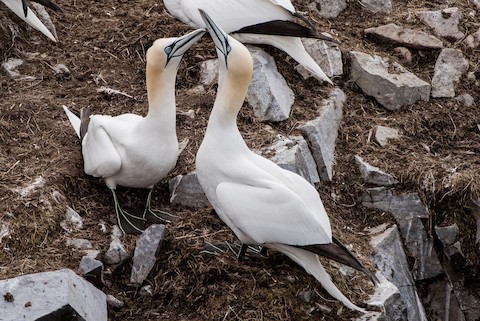
Northern Gannet pair in colony. (Cape St. Mary’s Ecological Reserve, Newfoundland; April 15, 2017.) © Frank King
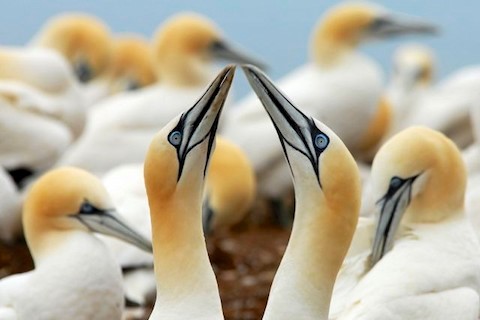
Northern Gannet pair in colony. (l’Île-Bonaventure-et-du-Rocher-Percé National Park, Quebec; July 15, 2007.) © Jacques Erard

Northern Gannet. (Peggy’s Cove, Nova Scotia; July 3, 2017.) © Keith Lowe
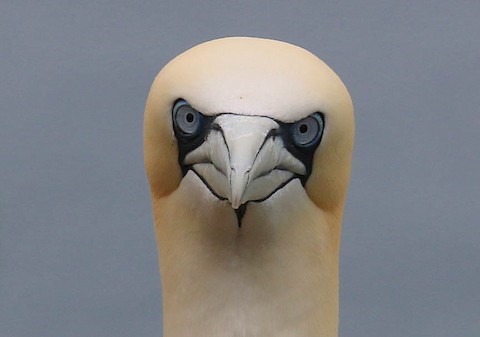
Northern Gannet. (Bempton Cliffs RSPB Reserve, Yorkshire, England; May 31, 2014.) © Mark Dennis
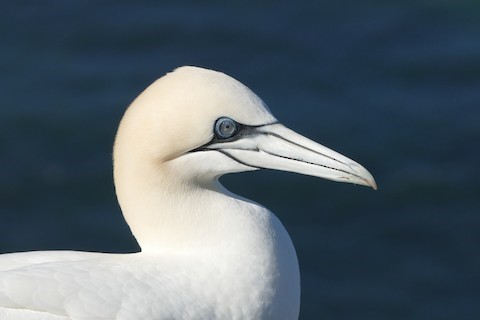
Northern Gannet. (Helgoland, Germany; May 10, 2015.) © Peter Kaestner
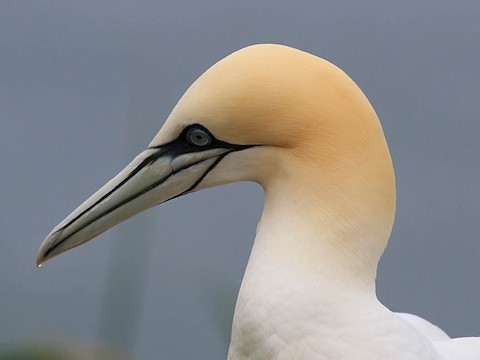
Northern Gannet. (Bempton Cliffs RSPB Reserve, Yorkshire, England; May 31, 2014.) © Mark Dennis
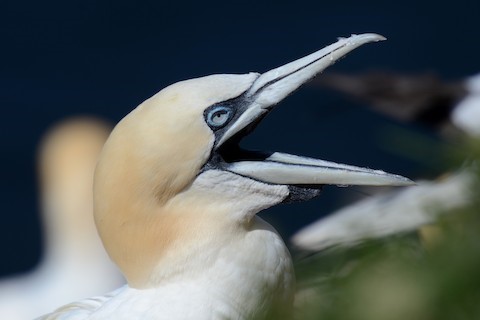
Northern Gannet. (Helgoland, Germany; June 3, 2013.) © Dirk Tomsa

Northern Gannet. (Cape Hatteras, North Carolina; April 7, 2016.) © Liam Wolff

Northern Gannet. (l’Île-Bonaventure-et-du-Rocher-Percé National Park, Quebec; July 1, 2016.) © Simon Boivin

Northern Gannet. (l’Île-Bonaventure-et-du-Rocher-Percé National Park, Quebec; July 30, 2015.) © Maurice Raymond

Northern Gannet, dorsal view showing simple adult pattern: white with wings black from the wrist out. (Cape St. Mary’s Ecological Reserve, Newfoundland; June 11, 2017.) © Laure Neish
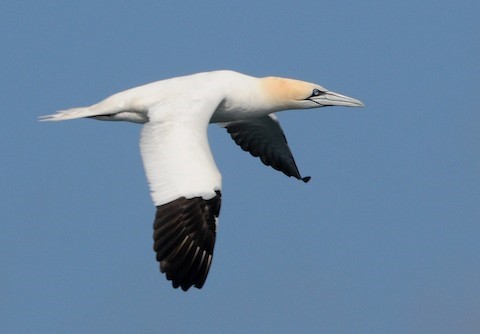
Northern Gannet. (Île Bono, Sept-Îles National Nature Reserve, Brittany, France; July 3, 2010.) © Volker Hesse
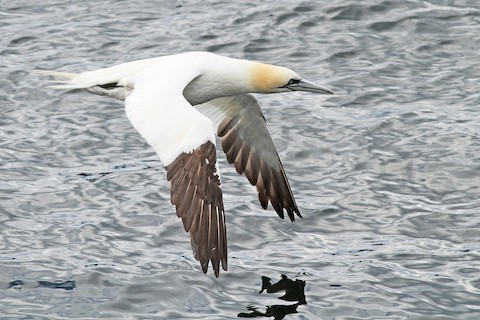
Northern Gannet, showing pattern on upperside and underside of adult’s wings. (Monhegan Island, Maine; September 24, 2012.) © Jeremiah Trimble
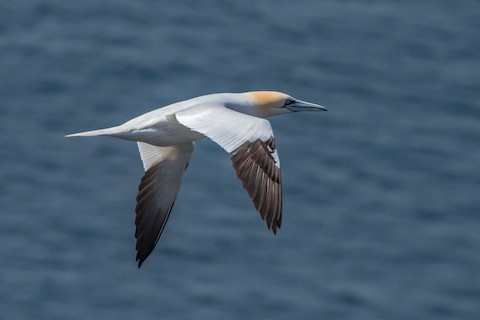
Northern Gannet, showing pattern on upperside and underside of adult’s wings. (Cape St. Mary’s Ecological Reserve, Newfoundland; April 15, 2017.) © Frank King
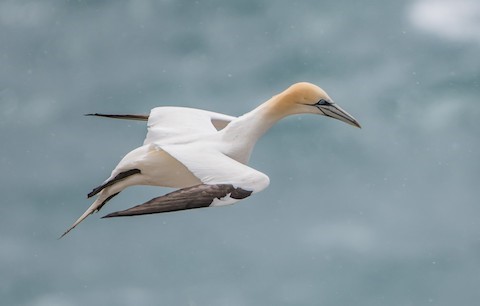
Northern Gannet, apparently beginning a dive. (Cape St. Mary’s Ecological Reserve, Newfoundland; April 21, 2018.) © Frank King
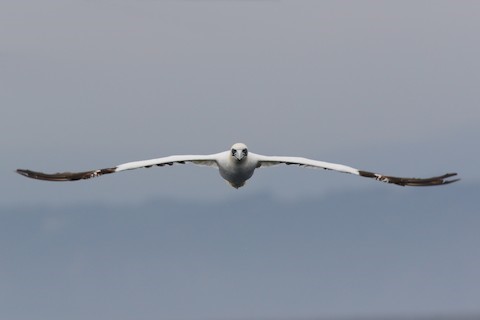
Northern Gannet. (Offshore from Gijón, Asturias, Spain; September 16, 2018.) © Rafael Merchante
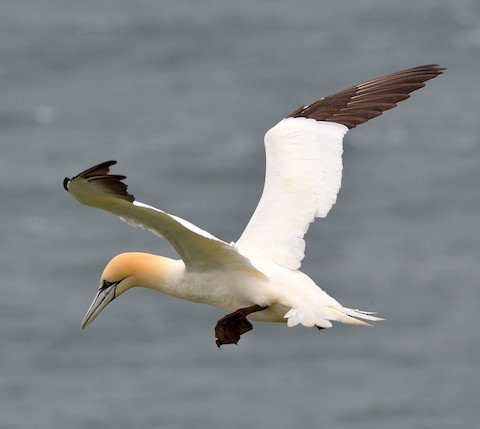
Northern Gannet. (Bempton Cliffs RSPB Reserve, Yorkshire, England; June 3, 2016.) © A. Emmerson
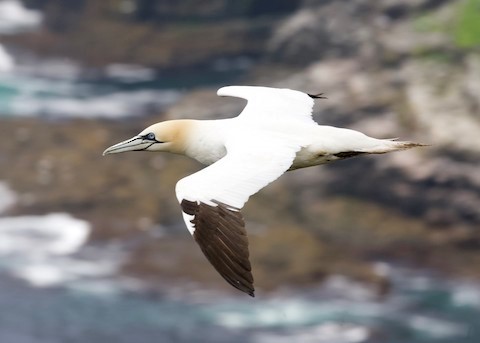
Northern Gannet, dorsal view showing simple adult pattern: white with wings black from the wrist out. (Cape St. Mary’s Ecological Reserve, Newfoundland; July 16, 2019.) © Nick Lund
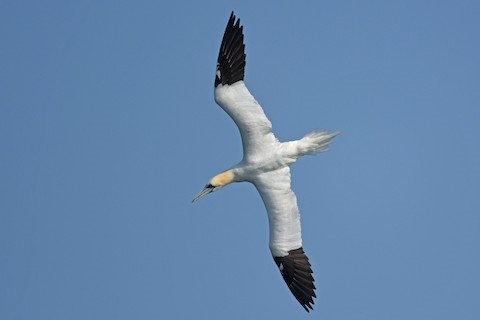
Northern Gannet, dorsal view showing simple adult pattern: white with wings black from the wrist out. (Havre-St-Pierre, Minganie, Quebec; July 28, 2019.) © Marie O’Neill
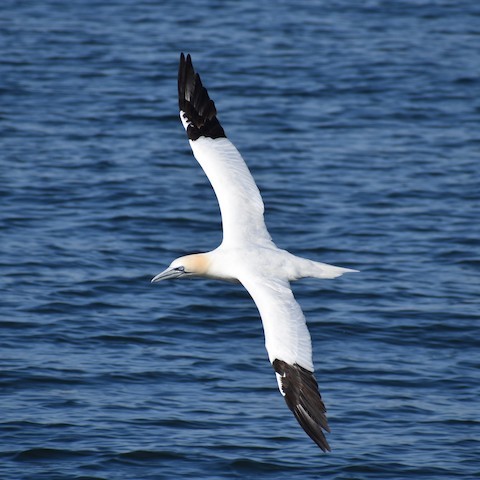
Northern Gannet, dorsal view showing simple adult pattern: white with wings black from the wrist out. (Virginia Beach, Virginia; February 3, 2019.) © Andrew Rapp
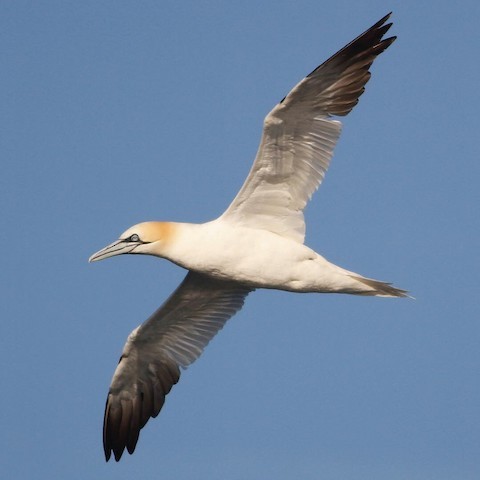
Northern Gannet, ventral view showing adult underwing pattern: white with black primaries. (Offshore from Fire Island, New York; November 4, 2018.) © Taylor Sturm
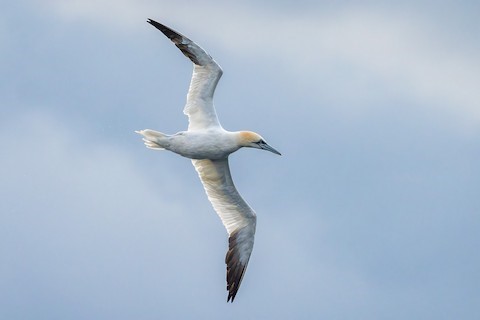
Northern Gannet, ventral view showing adult underwing pattern: white with black primaries. (Tarifa, Cádiz, Andalucía, Spain; January 10, 2021.) © Yeray Seminario

Northern Gannet. (Offshore from Lewes, Delaware; January 16, 2019.) © Sharon Lynn
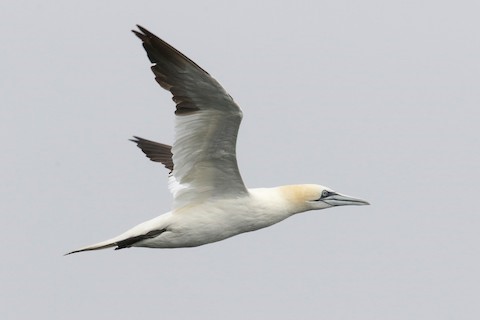
Northern Gannet. (Offshore from Shinnecock Inlet, New York; October 21, 2020.) © Noah Strycker
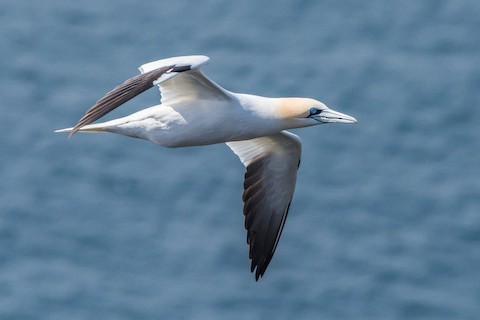
Northern Gannet. (Cape St. Mary’s Ecological Reserve, Newfoundland; April 15, 2017.) © Frank King
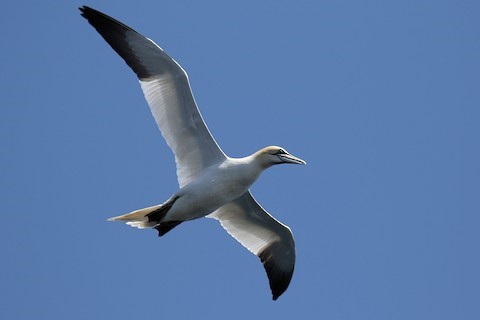
Northern Gannet. (Gull Island, Witless Bay Ecological Reserve, Newfoundland; June 30, 2017.) © Pavel Parkhaev
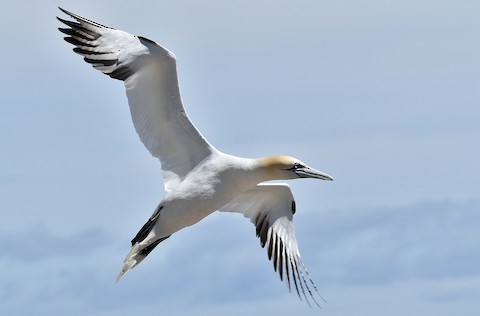
Northern Gannet. (l’Île-Bonaventure-et-du-Rocher-Percé National Park, Quebec; August 10, 2018.) © André Lanouette

Northern Gannet, ventral view showing adult underwing pattern: white with black primaries. (l’Île-Bonaventure-et-du-Rocher-Percé National Park, Quebec; July 30, 2015.) © Maurice Raymond

Northern Gannet. (Stonington Point, Connecticut; December 2, 2019.) © L. Olsen
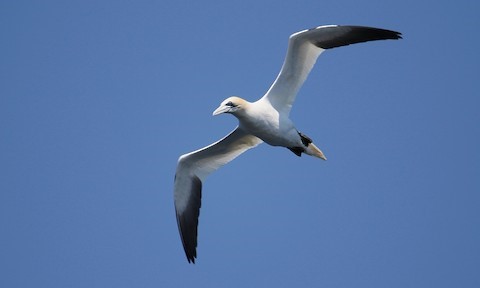
Northern Gannet. (Gull Island, Witless Bay Ecological Reserve, Newfoundland; June 30, 2017.) © Pavel Parkhaev

Northern Gannet. (Helgoland, Germany; August 2, 2009.) © Christoph Moning
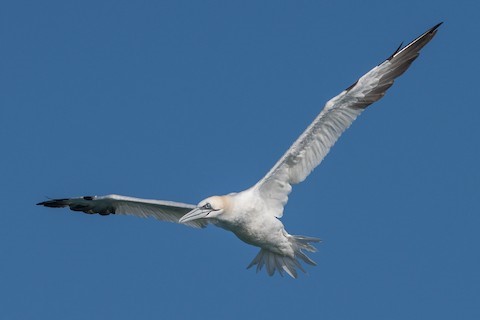
Northern Gannet. (Sebastian Inlet State Park, Florida; January 1, 2017.) © Peter Brannon
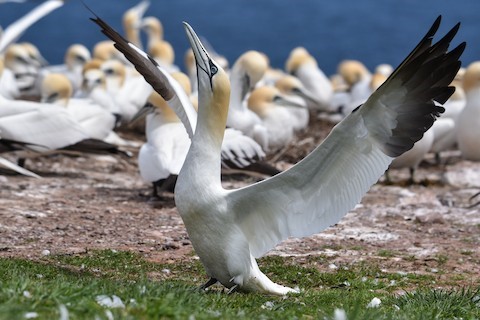
Northern Gannet. (l’Île-Bonaventure-et-du-Rocher-Percé National Park, Quebec; June 11, 2019.) © Maryse Neukomm
Immature Plumages. Juvenile is predominantly dark gray-brown with white dots, which can be either sparse or dense. The head, neck, and underparts are usually paler—i.e., more heavily spotted white.

Northern Gannet, juvenile. (Offshore from Lanzarote, Canary Islands, Spain; October 29, 2016.) © Miguel Rouco
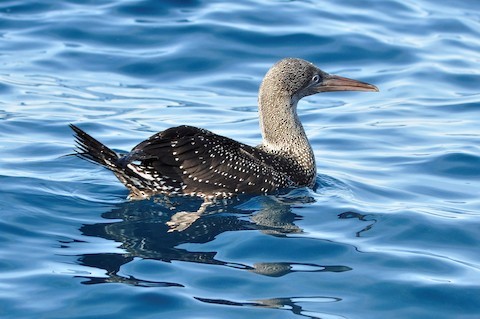
Northern Gannet, juvenile. (Offshore from Safres, Faro, Portugal; October 6, 2012.) © Jorge Safara
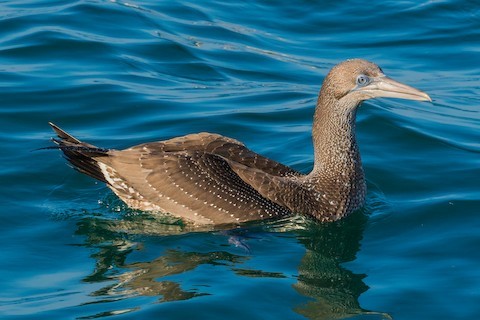
Northern Gannet, juvenile. (Offshore from La Grande-Motte, Languedoc-Roussillon, France; December 3, 2016.) © John Reynolds
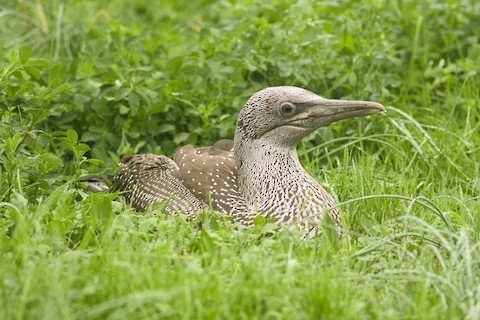
Northern Gannet, juvenile. (Lancaster, Pennsylvania; October 22, 2020.) © Zach Millen
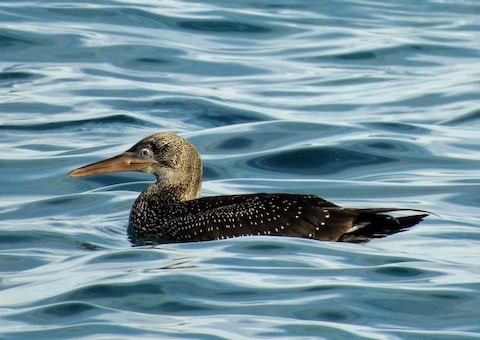
Northern Gannet, juvenile. (Boynton Beach Inlet Park, Florida; December 5, 2019.) © Matt Kennedy

Northern Gannet, juvenile. (Huguenot Memorial City Park, Duval County, Florida; December 21, 2019.) © David W. Foster
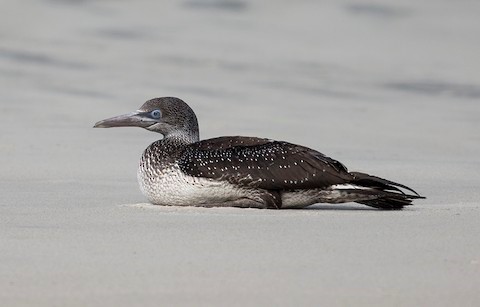
Northern Gannet, juvenile. (Cape Lookout National Seashore, North Carolina; February 5, 2017.) © Martin Wall
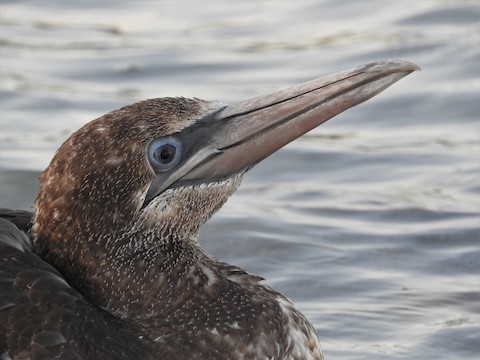
Northern Gannet, juvenile. (Crandon Park, Miami, Florida; March 23, 2019.) © Brendan Galvin

Northern Gannet, juvenile. (Offshore from La Grande-Motte, Languedoc-Roussillon, France; December 3, 2016.) © John Reynolds

Northern Gannet, juvenile. (Lake Erie, Ohio; November 23, 2013.) © Ron Sempier

Northern Gannet, juvenile—a very dark individual. (Offshore from Cataluña, Spain.) © Eduardo Soler

Northern Gannet, juvenile. (Offshore from Gijón, Asturias, Spain; September 16, 2018.) © Rafael Merchante

Northern Gannet, juvenile. (Wendy Park, Whiskey Island, Cleveland, Ohio; December 19, 2017.) © Don Danko
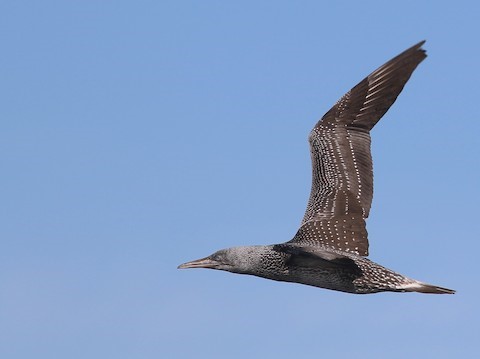
Northern Gannet, juvenile. (Offshore from Fire Island, New York; November 4, 2018.) © Shawn Billerman

Northern Gannet, juvenile—two very dark individuals. (Offshore from Safres, Faro, Portugal; October 6, 2012.) © Jorge Safara

Northern Gannet, juvenile. (Offshore from Cape Hatteras, North Carolina; February 17, 2019.) © Michael Todd
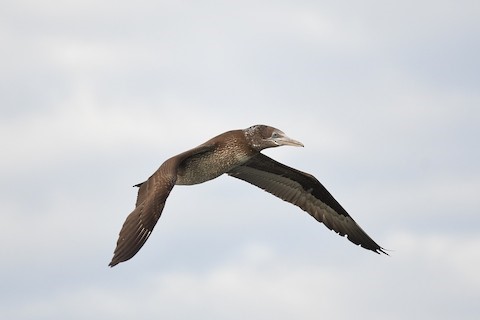
Northern Gannet, juvenile. (Offshore from Cape Hatteras, North Carolina; February 17, 2019.) © Matt Spangler

Northern Gannet, juvenile. (Race Point, Provincetown, Massachusetts; October 25, 2020.) © Tim Lenz
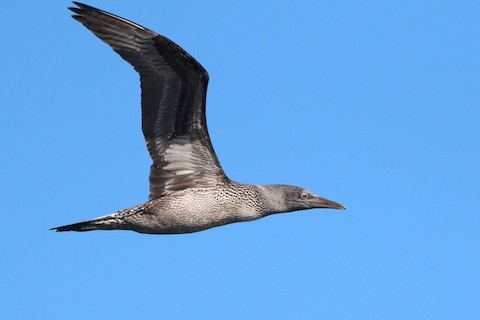
Northern Gannet, juvenile. (Offshore from Fire Island, New York; November 4, 2018.) © Brendan Fogerty
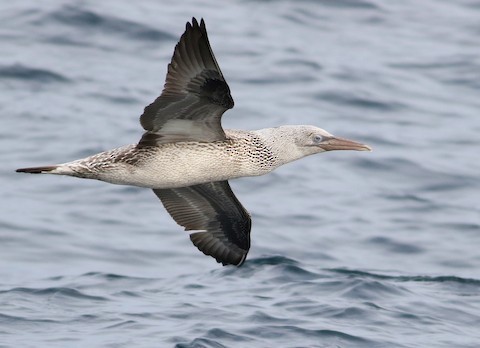
Northern Gannet, juvenile. (Offshore from Cape May, New Jersey; November 25, 2016.) © Karmela Moneta

Northern Gannet, juvenile. (Bell Bouy Boca Grande, offshore from Cayo Costa, Florida; January 31, 2021.) © Tammy McQuade

Northern Gannet, juvenile. (Beachway Park, Burlington, Ontario; November 24, 2017.) © Buddy M.

Northern Gannet, juvenile. (Siesta Key, Florida; November 23, 2017.) © Jeff O’Connell

Northern Gannet, juvenile. (Delaware Seashore State Park, Delaware; October 31, 2010.) © Jonathan Plissner
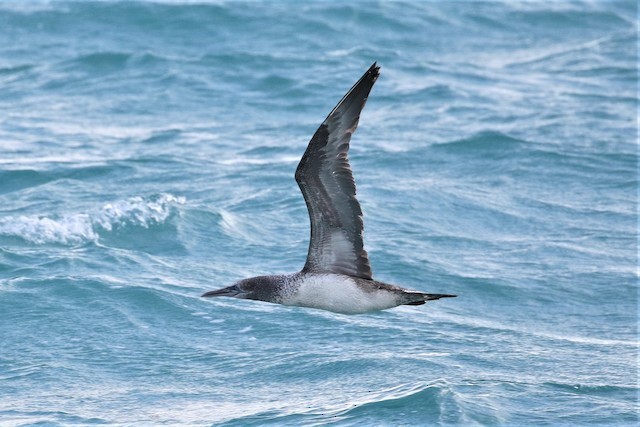
Northern Gannet, juvenile. (Dry Tortugas National Park, Florida; April 28, 2018.) © Anthony Vicciarelli
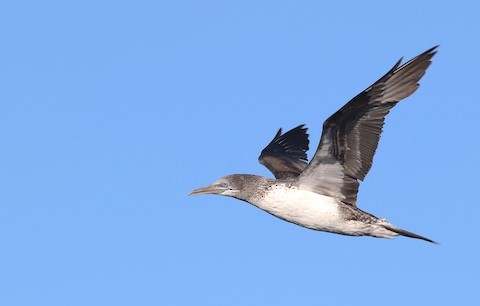
Northern Gannet, juvenile. (Offshore from Point Pleasant, New Jersey; November 4, 2018.) © Shawn Billerman
During the first year, immatures become paler in stages, with white feathers replacing dark ones on the head, rump, and underparts. The sequence, coloration, and pattern vary considerably. In some, the underparts turn white first. In others, the head turns white first (usually leaving a dark ring around the neck). In others, the underparts and head may turn white in unison.
While the rest of the plumage lightens, the upperparts darken and become almost entirely solid blackish-brown.
The bill begins as dark-gray, then becomes paler and usually pinkish, then eventually becomes paler and bluer before attaining the adult coloration—a bluish ivory. The feet begin as pale-gray, then darken to black.

Northern Gannet, immature. (Offshore from Chipiona, Cádiz, Andalucía, Spain; September 15, 2020.) © Yeray Seminario
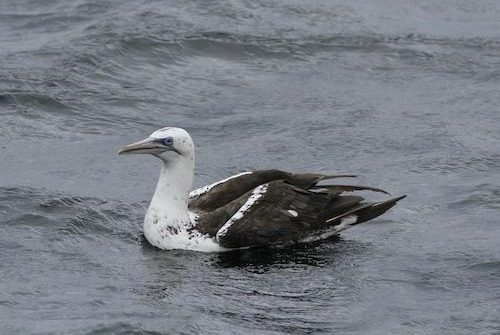
Northern Gannet, immature. (Offshore from Hancock, Maine; September 12, 2015.) © Kyle Lima

Northern Gannet, immature. (Offshore from Cape Hatteras, North Carolina; February 17, 2019.) © Michael Todd

Northern Gannet, immature. (Offshore southeast of Nantucket, Massachusetts; August 25, 2018.) © Sean Williams
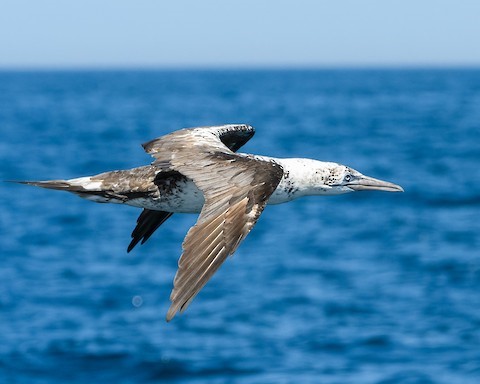
Northern Gannet, immature. (Offshore from Chipiona, Cádiz, Andalucía, Spain; September 5, 2020.) © Daniel Maza
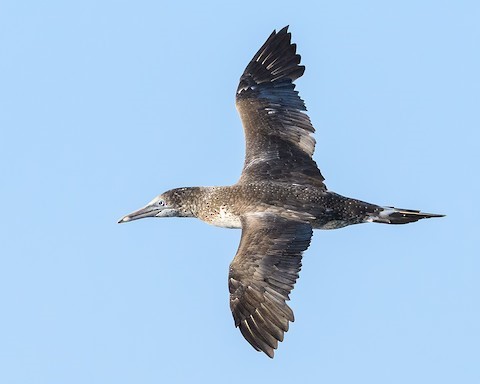
Northern Gannet, immature. (Offshore from Chipiona, Cádiz, Andalucía, Spain; September 5, 2020.) © Daniel Maza

Northern Gannet, immature. (Offshore east of Cape Sable Island, Nova Scotia; August 2, 2020.) © Alix d’Entremont
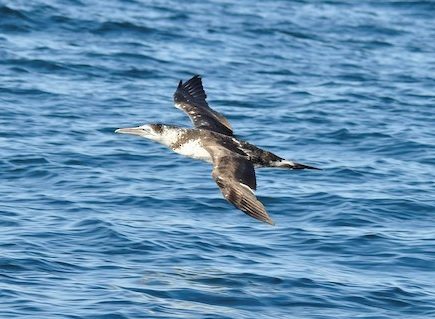
Northern Gannet, immature. (Offshore from Safres, Faro, Portugal; October 6, 2012.) © Jorge Safara
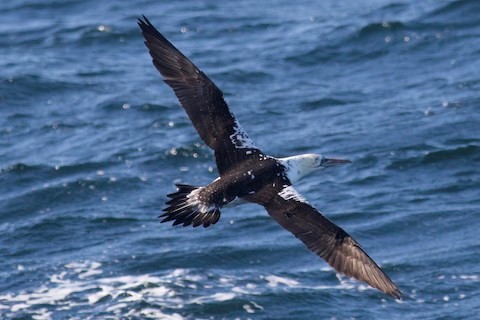
Northern Gannet, immature. (Offshore from Cape May, New Jersey; February 4, 2017.) © David Brown

Northern Gannet, immature. (Offshore from Island Beach State Park, New Jersey; November 8, 2020.) © Chris Thomas
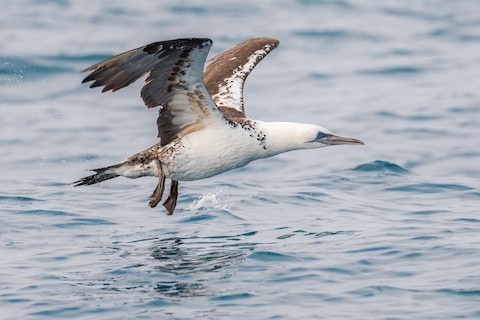
Northern Gannet, immature. (Offshore from Chipiona, Cádiz, Andalucía, Spain; September 15, 2020.) © Yeray Seminario
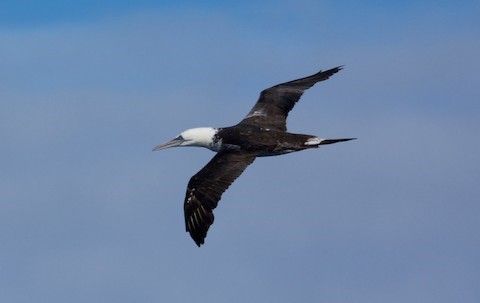
Northern Gannet, immature. (Offshore from Sagres, Faro, Portugal; October 7, 2015.) © Eric François Roualet

Northern Gannet, immature. (Cape St. Mary’s Ecological Reserve, Newfoundland; June 20, 2019.) © Lynette Spence

Northern Gannet, immature. (Offshore from Point Pleasant, New Jersey; November 4, 2018.) © Jay McGowan
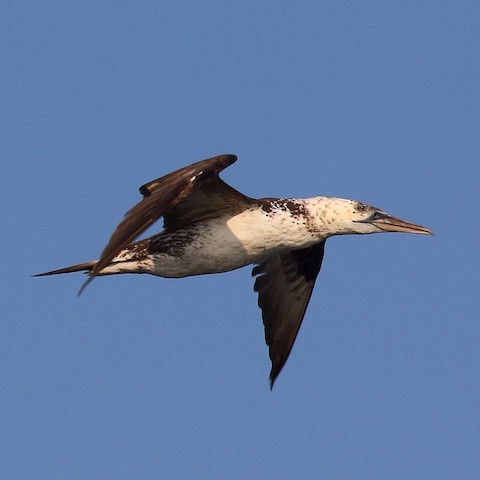
Northern Gannet, immature. (Eastern Egg Rock, Maine; July 28, 2019.) © Dan Vickers
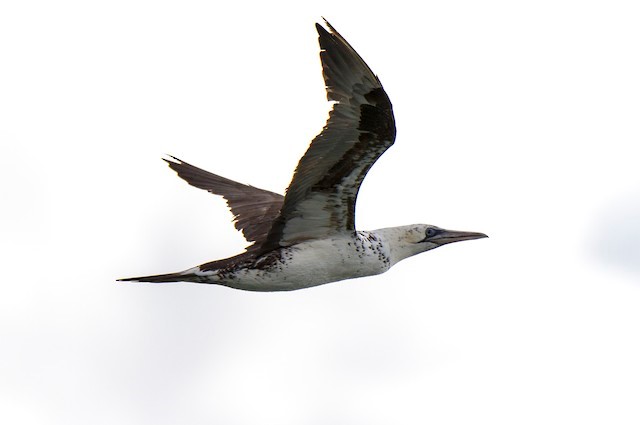
Northern Gannet, immature. (Marismas de Santoña, Victoria y Joyel Natural Park, Spain; July 1, 2017.) © Javier Hernández
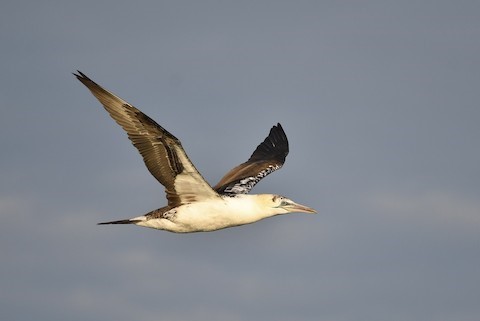
Northern Gannet, immature. (Offshore from Cape Hatteras, North Carolina; February 17, 2019.) © Matt Spangler
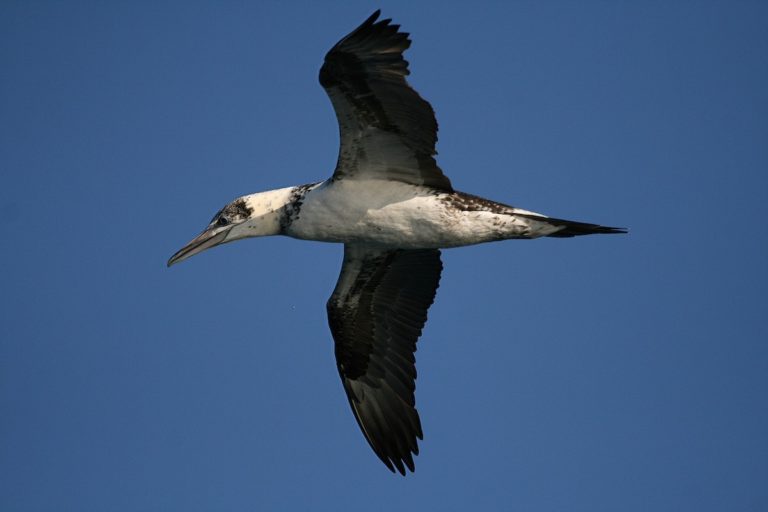
Northern Gannet, immature. (Offshore from Cataluña, Spain.) © Eduardo Soler
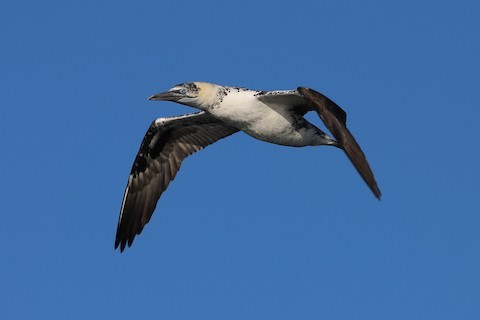
Northern Gannet, immature. (Offshore from Cape Hatteras, North Carolina; January 26, 2019.) © Nick Newberry

Northern Gannet, immature. (Offshore from Fire Island, New York; November 4, 2018.) © Jay McGowan
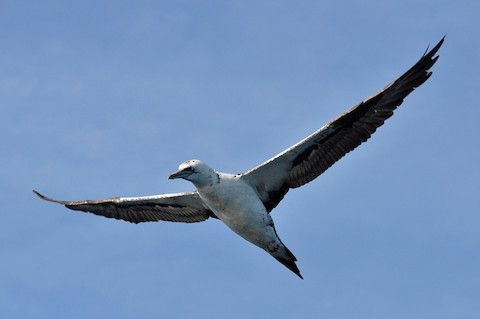
Northern Gannet, subadult. (Offshore from Safres, Faro, Portugal; October 6, 2012.) © Jorge Safara

Northern Gannet, immature. (Virginia Beach, Virginia; February 3, 2019.) © Diane Lepkowski
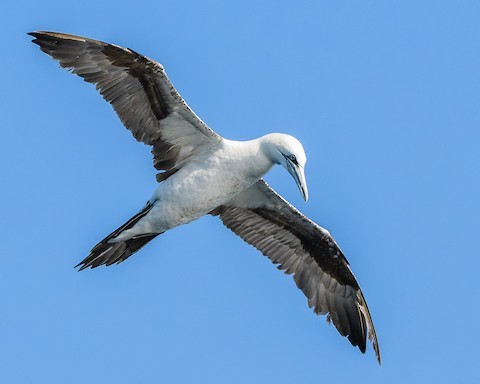
Northern Gannet, immature. (Offshore from Chipiona, Cádiz, Andalucía, Spain; September 5, 2020.) © Daniel Maza
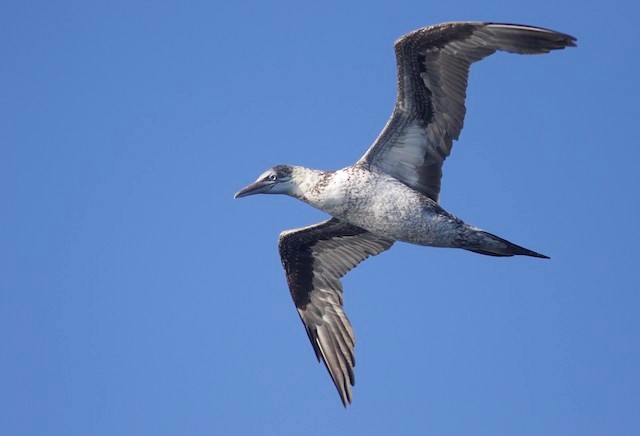
Northern Gannet, immature. (Offshore from York, Maine; October 21, 2017.) © Doug Hitchcox
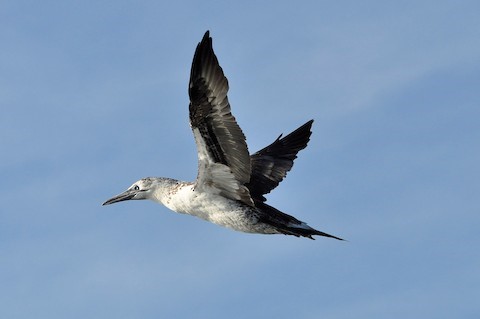
Northern Gannet, immature. (Offshore from Safres, Faro, Portugal; October 6, 2012.) © Jorge Safara
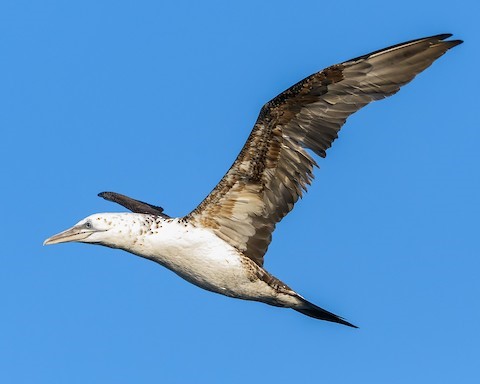
Northern Gannet, immature. (Offshore from Chipiona, Cádiz, Andalucía, Spain; September 5, 2020.) © Daniel Maza
Subadult Plumages. During their second and third years, subadults replace most of the dark upperparts with white. By these ages, most have acquired a yellowish blush on the head and nape.
Typically, the secondaries and tail remain black while the rest of the plumage turns white.
The last vestiges of immature plumage are usually black central tail feathers and a few outer secondaries.

Northern Gannet, subadult. (Bempton Cliffs RSPB Reserve, Yorkshire, England; June 4, 2016.) © Rodney Baker
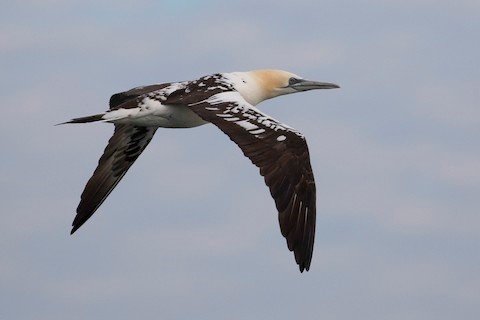
Northern Gannet, subadult. (Offshore from Cape Hatteras, North Carolina; February 17, 2019.) © Michael Todd
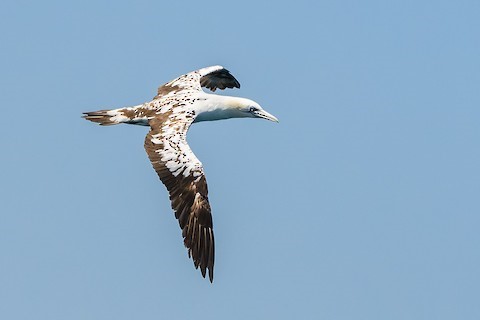
Northern Gannet, subadult. (Offshore from Chipiona, Cádiz, Andalucía, Spain; September 5, 2020.) © Daniel Maza
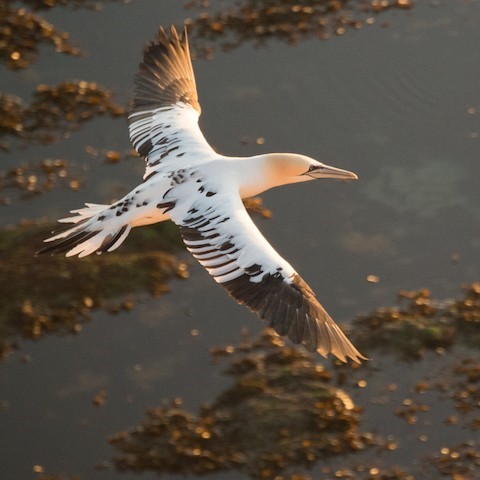
Northern Gannet, subadult. (Helgoland, Germany; May 17, 2014.) © Stefan Thiel
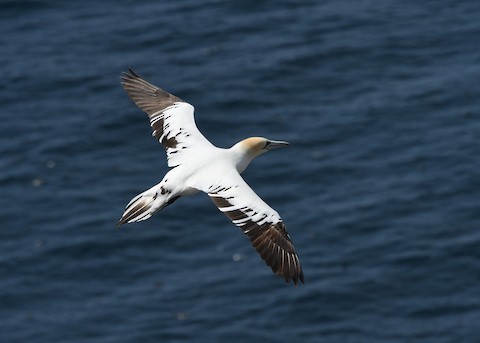
Northern Gannet, subadult. (Cape St. Mary’s Ecological Reserve, Newfoundland; July 20, 2019.) © Brett Sandercock
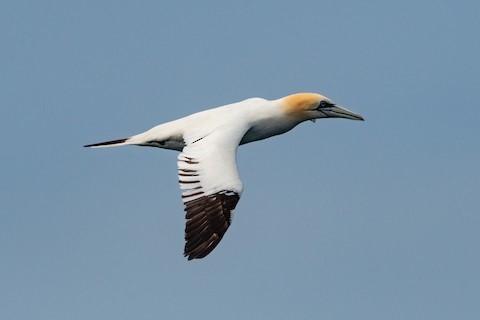
Northern Gannet, subadult. (Runde, Møre og Romsdal, Norway; June 24, 2019.) © Hans Norelius
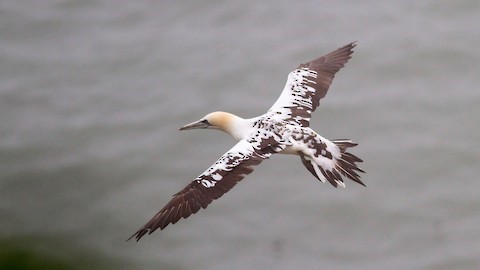
Northern Gannet, subadult. (Bempton Cliffs RSPB Reserve, Yorkshire, England; June 4, 2016.) © Rodney Baker
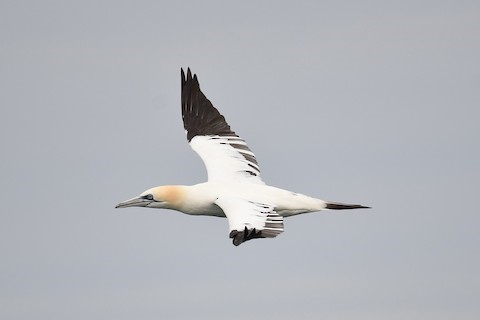
Northern Gannet, subadult. (Offshore from Cape Hatteras, North Carolina; February 17, 2019.) © Matt Spangler
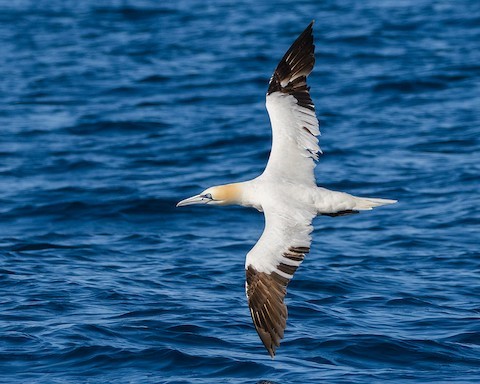
Northern Gannet, with a few vestigial, asymmetrical black feathers in the secondaries. (Offshore from Chipiona, Cádiz, Andalucía, Spain; September 5, 2020.) © Daniel Maza
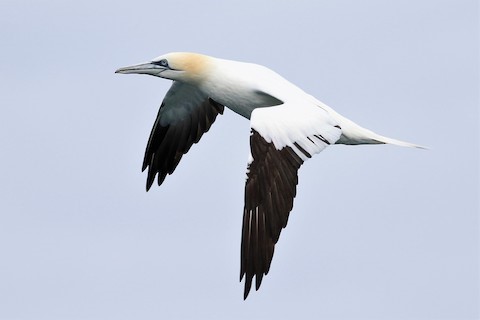
Northern Gannet, with a few vestigial black feathers in the secondaries. (Offshore from Cape Hatteras, North Carolina; February 17, 2019.) © Peter Flood
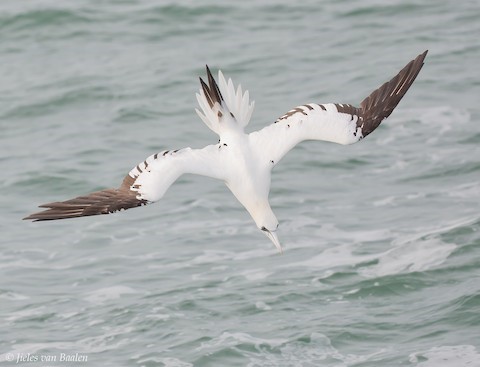
Northern Gannet, subadult. (Offshore from Zeeland, Netherlands; November 8, 2015.) © Jieles van Baalen
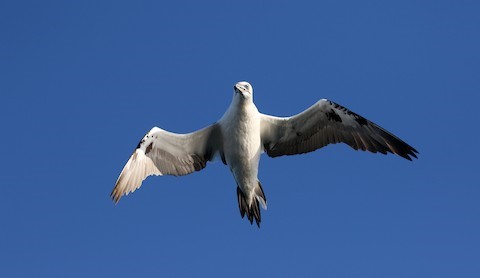
Northern Gannet, subadult. (Offshore from Point Pleasant, New Jersey; November 4, 2018.) © Jay McGowan
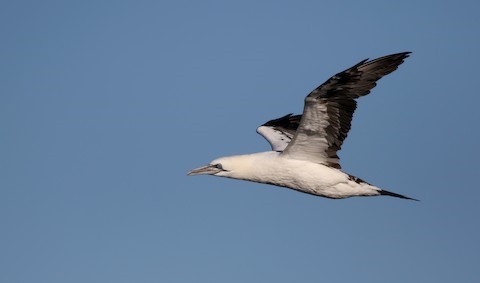
Northern Gannet, subadult with mostly black underwings and tail. (Offshore from Point Pleasant, New Jersey; November 4, 2018.) © Jay McGowan

Northern Gannet, subadult with black feathers in underwing linings and tail. (Helgoland, Germany; August 3, 2009.) © Christoph Moning

Northern Gannet, subadult showing mostly black secondaries. (Offshore from Cape Hatteras, North Carolina; February 17, 2019.) © Michael Todd
Cf. Cape Gannet. Northern and Cape Gannets both occur sparingly along the West African coast—they are not known to overlap regularly but in some areas both species would seem to be about equally likely to occur. The most consistent difference is the strip of bare black skin on the throat, which is significantly longer on Cape than on Northern, but this may not be clearly visible, and even when visible it can be ambiguous in some postures.
Full adults differ in that Cape has an entirely black tail and entirely black secondaries, whereas these feathers are all-white on adult Northern and mixed white and black on subadult Northern.
Younger immature gannets in the tropical Atlantic would be challenging to identify. In general, juvenile Cape Gannet is darker than juvenile Northern, especially on the underparts, but Northern is quite variable. At some molt stages, they may not be reliably distinguishable.
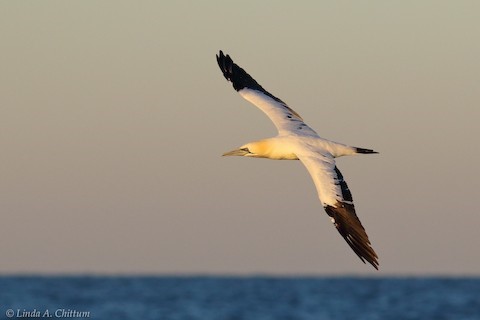
Northern Gannet, subadult with plumage nearly identical to that of adult Cape Gannet. (Offshore from Virginia Beach, Virginia; January 2, 2016.) © Linda Chittum
Cf. Australasian Gannet. Australasian Gannet’s plumage is generally intermediate between Northern and Cape, but it lacks Cape’s extended black skin on the throat and therefore resembles Northern more than Cape. It has been recorded from southern Brazil and South Africa, and therefore has some (albeit minimal) potential to overlap with Northern Gannet. Adults would be distinguishable if seen well, but younger Australasian and Northern may be effectively identical.
Cf. Masked Booby. Masked Booby and Northern Gannet overlap to some extent in the waters of the southeastern U.S. and West Indies, and can be difficult to distinguish as immatures. Juveniles and full adults are generally distinguishable by head color. Masked Booby begins with a dark head and clean-white underparts, a combination that does not occur in Northern Gannet. Late-stage subadult gannets have a distinct buffy or yellowish tinge on their heads, which does not occur in Masked Booby.
Older immatures and young subadults of the two species are variable and can resemble one another: with a mostly white head and underparts, and mostly blackish upperparts, tail, and flight feathers. Some early subadult Masked may have a dark partial collar, much like a gannet of the same age. At these stages, the most consistent, readily observable differences are in the bill and face color. The gannet’s bill turns from pinkish-gray to bluish-gray while Masked Booby’s bill is pale greenish-yellow or distinctly yellow. The gannet has a narrow fringe of blackish or blackish-blue facial skin while Masked Booby has a broad fringe of blackish or blackish-blue facial skin.
Notes
Monotypic species.
References
Alderfer, J., and J.L. Dunn. 2014. National Geographic Complete Birds of North America (Second Edition). National Geographic Society, Washington, D.C.
BirdLife International. 2018. Morus bassanus. The IUCN Red List of Threatened Species 2018: e.T22696657A132587285. https://dx.doi.org/10.2305/IUCN.UK.2018-2.RLTS.T22696657A132587285.en. (Accessed February 18, 2021.)
eBird. 2021. eBird: An online database of bird distribution and abundance. Cornell Lab of Ornithology, Ithaca, N.Y. http://www.ebird.org. (Accessed February 18, 2021.)
Garcia-del-Rey, E. 2011. Field Guide to the Birds of Macaronesia: Azores, Madeira, Canary Islands, Cape Verde. Lynx Editions, Barcelona.
Harrison, P. 1983. Seabirds: An Identification Guide. Houghton Mifflin, Boston.
Howell, S.N.G., and S. Webb. 1995. A Guide to the Birds of Mexico and Northern Central America. Oxford University Press.
Kirwan, G.M., A. Levesque, M. Oberle, and C.J. Sharpe. 2019. Birds of the West Indies. Lynx Edicions, Barcelona.
Mullarney, K., L. Svensson, D. Zetterström, and P.J. Grant. 1999. Birds of Europe. Princeton University Press.
Nelson, J.B. 2005. Pelicans, Cormorants and Their Relatives. Oxford University Press.
Sibley, D.A. 2000. The Sibley Guide to Birds. Alfred A. Knopf. New York.
van Perlo, B. 2002. Birds of Western and Central Africa. Princeton University Press.
Xeno-Canto. 2021. Northern Gannet – Morus bassanus. https://www.xeno-canto.org/species/Morus-bassanus. (Accessed February 18, 2021.)
